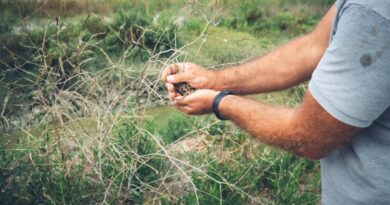Understanding Ecosystems Through Case Studies
Welcome to a journey of exploration into the intricate world of ecosystems through the lens of case studies. Ecosystems, the complex networks of living organisms and their environment, play a vital role in maintaining the balance of our planet. By delving into real-life examples and studies, we can gain a deeper understanding of the relationships, interactions, and dynamics within ecosystems. Join us as we uncover the wonders of nature and the interconnectedness of all living beings through the study of ecosystems.
The Importance of Ecosystems

Ecosystems are the foundation of life on Earth, providing essential services such as clean air, water, food, and medicine. They regulate the climate, control pests, pollinate crops, and recycle nutrients. Understanding ecosystems is crucial for conservation efforts, sustainable development, and biodiversity preservation. By studying ecosystems, scientists can better predict and mitigate the impacts of human activities on the environment.
The Concept of Ecosystems

An ecosystem consists of a community of organisms interacting with each other and their physical environment. It can be as small as a pond or as vast as a forest. Each ecosystem has its unique characteristics, including the diversity of species, energy flow, and nutrient cycles. Studying ecosystems involves analyzing the relationships between living organisms, such as plants, animals, and microorganisms, and their abiotic surroundings, like soil, water, and climate.
Case Study: The Coral Reef Ecosystem

One of the most diverse ecosystems on Earth is the coral reef. Coral reefs are underwater structures made of calcium carbonate secreted by corals. They support a wide variety of marine life, including fish, invertebrates, and algae. Coral reefs are crucial for coastal protection, fisheries, and tourism. However, they are facing threats from climate change, overfishing, pollution, and ocean acidification.
By studying coral reef ecosystems, scientists can understand the delicate balance between corals, algae, and other organisms. They can investigate the effects of rising sea temperatures on coral bleaching, the impact of nutrient runoff on algal blooms, and the role of predators in maintaining ecosystem health. Case studies of coral reefs highlight the interconnectedness of species and the vulnerability of these fragile ecosystems to human activities.
The Dynamics of Ecosystems

Ecosystems are dynamic and constantly changing in response to internal and external factors. Natural disturbances like wildfires, hurricanes, and disease outbreaks can disrupt ecosystem processes. Human activities such as deforestation, pollution, and urbanization can alter ecosystems on a larger scale. Understanding the dynamics of ecosystems requires monitoring population trends, tracking energy flow, and studying ecosystem resilience.
Case Study: The Amazon Rainforest Ecosystem
The Amazon rainforest is the largest tropical rainforest in the world, home to a vast array of plant and animal species. It plays a crucial role in regulating the global climate by absorbing carbon dioxide and releasing oxygen. The Amazon rainforest is facing threats from deforestation, illegal logging, and climate change. Case studies of the Amazon ecosystem reveal the interconnectedness of species, the importance of biodiversity, and the impacts of human activities on the environment.
Researchers study the Amazon rainforest ecosystem to understand the interactions between trees, animals, and microorganisms. They investigate the effects of droughts, wildfires, and land use changes on ecosystem dynamics. By analyzing satellite data, conducting field surveys, and using mathematical models, scientists can assess the health of the Amazon rainforest and develop strategies for conservation and sustainable management.
The Resilience of Ecosystems
Ecosystems have the capacity to adapt to changing conditions and recover from disturbances. This resilience is essential for maintaining ecosystem functions and supporting biodiversity. Resilient ecosystems can withstand environmental changes, resist invasive species, and recover from natural disasters. Studying ecosystem resilience can provide insights into adaptation strategies, restoration practices, and conservation efforts.
Case Study: The Everglades Ecosystem
The Everglades in Florida is a unique wetland ecosystem known for its biodiversity and water flow. It serves as a habitat for numerous species of birds, fish, and plants. The Everglades ecosystem has been impacted by drainage, pollution, and invasive species, leading to a decline in water quality and wildlife populations. Case studies of the Everglades highlight the importance of ecosystem services, the role of restoration projects, and the challenges of managing a complex ecosystem.
Scientists study the Everglades ecosystem to assess water quality, monitor wildlife populations, and restore natural habitats. They analyze the effects of invasive species like pythons, the benefits of wetland restoration, and the interactions between different species. By understanding the resilience of the Everglades ecosystem, researchers can develop sustainable solutions to protect this valuable ecosystem for future generations.
The Future of Ecosystems
The future of ecosystems is uncertain due to ongoing environmental changes and human activities. Climate change, habitat destruction, pollution, and overexploitation threaten the stability and health of ecosystems worldwide. To ensure the long-term sustainability of ecosystems, we must adopt conservation practices, reduce our ecological footprint, and promote biodiversity protection. Studying ecosystems through case studies can help us make informed decisions and take action to safeguard the natural world.
Common Misconceptions
One common misconception about ecosystems is that they are static and unchanging. In reality, ecosystems are dynamic and responsive to environmental changes. Another misconception is that human activities have no impact on ecosystems. In truth, human activities can have profound effects on ecosystem health and biodiversity. By dispelling these misconceptions and promoting awareness of ecosystem dynamics, we can work towards a more sustainable coexistence with nature.
Conclusion
As we conclude our exploration of ecosystems through case studies, we are reminded of the intricate web of life that connects all living beings on Earth. Ecosystems are not just a collection of plants and animalsthey are complex systems of interdependent relationships and processes that sustain life on our planet. By studying ecosystems, we can better appreciate the beauty of nature, the resilience of life, and the importance of conservation. Let us cherish and protect our ecosystems for the benefit of present and future generations. Together, we can make a difference in understanding, preserving, and nurturing the precious ecosystems that sustain us all.
To wrap things up, let us remember that each ecosystem is a unique and valuable treasure worth protecting. By learning from case studies, we can deepen our understanding of the wonders of nature and the delicate balance of life. Let us be stewards of the Earth, guardians of biodiversity, and champions of sustainability. Together, we can ensure a harmonious future where ecosystems thrive, and all species coexist in harmony.




